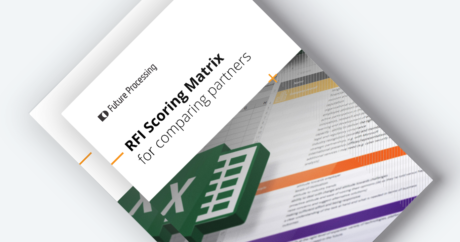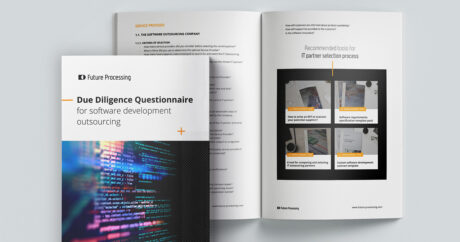Like many other sectors these days, the insurance is undergoing digital transformation. Digital transformation is not something to be done lightly, so insurance companies seek technology experts to deliver the best solution to meet their needs. This is where requests for proposals (RFPs) become crucial as they allow insurance companies to find the right provider. How to prepare an effective RFP for digital transformation in the insurance sector?
Why is Digital Transformation Crucial for Today’s Insurance Companies?
The insurance industry has fallen behind technologically in comparison with other sectors. In the context of the development of technology and digital transformation, the sector remained behind for many years because of a complex process structure, demanding legal regulations, and the conservative nature of traditional business models. Many insurance organisations still rely on aged systems, old infrastructure, and manual work, which involve high operational costs and risk of errors. To solve these problems, insurance organisations, e.g. London insurers, turn to digital transformation.
Digital transformation is a process of leveraging and enhancing technological possibilities that can positively impact the company’s overall efficiency, add value for internal and external clients, and ultimately lead to innovation in the business field. The insurance sector can first and foremost benefit from:
- Digitalising claims management,
- Innovating digital underwriting workbench,
- Migrating legacy core business systems to cutting-edge technologies,
- Design thinking and strategy workshops aimed at ecosystem planning,
- Cloud migration and modernisation,
- Complex data cleaning and data migration,
- Delivering bespoke solutions based on Artificial Intelligence, Machine Learning, and microservices,
- Improving the overall quality, reliability, and efficiency of applications while cutting down costs,
- Processes automation, using the low-code and no-code technology,
- Enhancing customer experience.
Main Technological Trends in the Insurance Sector
Despite the challenges of building software in insurance, there are many paths of digital transformation in the insurance sector to choose from but only a few main roads are actually taken by insurance companies. The overall goal of digital transformation for the insurers is to streamline the processes to make them more error-proof and shorter for customers.
(Core) Insurance System Modernisation
For insurance companies, a core system is the central software to manage key business processes, e.g. policy processing, claim filing, financial settlement, and risk management. The core system is the key element of an insurer’s technological infrastructure as it handles all strategic operations, data management, reporting, and analytics. Many companies still rely on obsolete legacy systems, infrastructure, and human work, which could be effectively modernised and optimised.
Underwriting Digital Transformation
Underwriting is one of the key processes in insurance. It involves evaluating, defining, and pricing insurance and reinsurance risks, including, where appropriate, the rejection of such risks. For many years, insurers have relied on dispersed databases or overlapping systems with data entered manually. Digital transformation in this area aims at greater efficiency, better integration with business lines, and data standardisation. Data and solutions are integrated to make the analysis easier for underwriters.
Digital Claims
This trend aims at improving claims handling and claims management. Currently, insurers struggle with human-made errors, excessive reliance on separate systems and spreadsheets, and complex and lengthy decision-making procedures. Insurers turn to digital transformation because they want to make the process smoother, shorter, and error-free.
Cybersecurity
It’s not surprising that insurers also focus on security as part of digital transformation. A cyber-attack against an insurance company can have far-reaching consequences. Among others, this means financial losses, image loss, losing customers’ trust, service downtime, and even, in the long-term, worse financial results for the company. However, digital transformation is also driven by changing legislation or regulations that require improved cybersecurity measures.
Insurance Ecosystem Strategy
An insurance ecosystem is based on the cooperation of several entities (e.g. their products and services) to gain value that is larger than what they could achieve on their own. A proper insurance ecosystem strategy can help insurers increase revenue with efficient processes, improve customer experience through better services, and create new products thanks to higher innovation.
Essential Elements of a Successful RFP for Digital Transformation in Insurance
In all business sectors, a request for proposal (RFP) is a document that gives prospective vendors all the specific information necessary to develop a technological solution, based on the actual requirements. Drafting a successful request for proposal is challenging, and this holds especially true for digital transformation in insurance.
The essential elements of an RFP are:
- Project Information
- Supplier Questionnaire
The project information is something like an introduction to tell potential partners about your company, present the area of expertise, determine a rough scope of the project, and assess the timeline and the available budget.
The supplier questionnaire section gathers information from the potential suppliers. Normally, it includes numerous questions and topics, but the best RFPs also feature “knockout” questions. Their goal is to filter out prospective vendors purely on the basis of their responses to those questions. Also, the questionnaire should support a weight-scoring mechanism to make the comparison of the proposals easier.
Key Considerations for Insurance Providers During Digital Transformation RFP
While working on an RFP in the insurance sector, you should take the following issues into consideration to achieve successful digital transformation:
- Process optimisation and automation – the prospective vendor should be able to deliver a solution that will solve the most pressing problems, especially those related to manual data processing.
- Data-driven decision-making – the winning proposal should provide a solution that combines dispersed resources so that underwriters can make better and faster data-based decisions.
- Customer-centricity – the insurer’s customer needs and experience should be placed in the centre, as many insurance companies focus too much on the product and too little on the customer.
- Technology partnerships – simple in-house building or buying a digital solution isn’t always the best option, as technological partners can often prove to be better providers of well-tested and tailored solutions.
- Culture of innovation – digital transformation can drive innovation not only by directly impacting the problems it tries to solve but also by creating a wider culture of innovation throughout the organisation.
Common Oversights in Digital Transformation RFP of Insurance
Just as there are some surefire ways of creating a comprehensive request for proposal, there are certain aspects that can make the whole process and its outcome far from desirable. These oversights can turn an RFP into a rather impractical tool for digital transformation:
- Lacking clarity – if you approach the RFP without clear objectives, budget, goals, or expectations, you’re likely to miss the point of the whole process, which is to make an informed decision as to the vendor of your digital transformation.
- Creating an overwhelming questionnaire – a questionnaire that has hundreds of questions, some of which are vague or irrelevant, without a good scoring mechanism, and with poor formatting (tiny spreadsheet cells obscuring crucial data), may become a hindrance rather than help. If you send such a questionnaire to many partners, the whole evaluation process will take too much time and resources.
- Putting too much faith in the spreadsheet – the RFP questionnaire, especially if it’s a spreadsheet, is only a tool. It helps establish a score to determine the final vendor but there may be cases when it’s better to take some other criteria into account, like the flow of cooperation with the vendor’s team during the preliminary stages or the product demo.
Best Practices for a Flawless RFP Process for Insurance Market
Avoiding the common oversights is the first step on the path to a flawless request for proposal process but there are more steps to be taken to make the road even smoother.
First of all, you should establish the priorities. What is the goal of the RFP? What are the objectives? What trends of the digital transformation in insurance are to be covered? Are the required objectives clearly communicated to the prospective vendors? Finding answers to these questions will help you prepare a focused RFP.
Next, the RFP questionnaire should be exhaustive but not overwhelming in its form and length, and it should include several knockout questions. A concise questionnaire can be sent to many providers to give you a wide range of options. All the information gathered should be structured and promote an objective comparison of the prospective vendors. The team that evaluates the RFP questionnaire should be able to efficiently assess the data provided to make as informed a decision as possible.
Then, create a shortlist of the best vendors and invite them to a workshop or demo session. Try getting to know the team that’s going to solve your problem and learn if the cooperation at this stage bodes well for the whole project.
Last but not least, don’t rush the RFP process. While the RFP questionnaire should be structured in a way that makes its evaluation fairly fast and efficient, it doesn’t mean that cutting corners is the way to go. Digital transformation is a costly and time-consuming process so a seamless RFP process should promote deliberate decision-making instead of jumping to conclusions.
If you need more inspiration, there are even more RFP practices to be explored.
Checklist for Finalising Your RFP in the Digital Transformation Journey
If you need a quick checklist before you create out your RFP, here’s one for you:
- Have you clearly determined your digital transformation objectives for the RFP process?
- Have you set up a budget?
- Do you have a time-frame for the whole RFP process?
- Have you created a list of prospective vendors?
- Do your prospective vendors have all the necessary details to smoothly participate in the RFP?
- Does your RFP questionnaire have clear and exhaustive questions and supports informed decision making?
- Does your RFP process include demo sessions or workshops?
With these guidelines, your RFP for the digital transformation in the insurance sector will become a much smoother process that will surely and safely guide you to make an informed decision and pick the best fitting partner. A well-designed RFP is bound to be a great leap towards the digital transformation of your insurance company that will help you stay ahead of the game in the fast-changing business reality.


